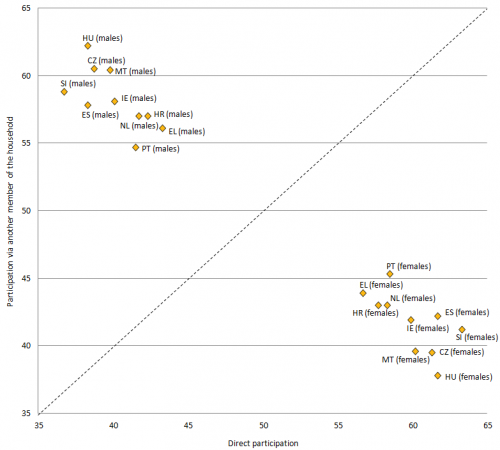This article documents the implementation of the ad-hoc module on the employment situation of people with disabilities included in the 2011 EU Labour force survey. Its purpose is to evaluate how using a proxy affected responses. Proxy use means that another member of the household took part in the survey on behalf of the person with a disability. This ad-hoc module was carried out in 32 countries: the EU-28 Member States plus Iceland, Norway, Turkey and Switzerland. It is part of an online publication on Disability.
Proxy use by country
Table 1 shows those countries that allowed another household member to take part in the ad-hoc module of the 2011 EU Labour Force Survey, and those that did not. The only countries that did not allow use of proxies were Belgium, France and Norway - although France did permit proxy use if the person concerned was unable (for health reasons) to answer without assistance.
Figure 1 shows the percentages of people questioned directly and the percentages of those included in the survey through another household member. The use of proxies varied from 1% (Sweden) to 58% (Slovenia). The overall EU rate was 35%. Although Belgium had a formal ban on using proxies, the proxy use rate was 15% in practice.
Profile of the proxies
In 10 countries, about half of those surveyed had proxies
This section describes the profiles of people who used a proxy. Table 2 shows the distribution of participants by proxy use for a selection of demographic variables. It reveals differences between the profiles of people who were represented by another household member and those who responded directly, covering the 10 countries with most proxy interviews: Slovenia (58%), Spain (55%), Malta (52%), the Netherlands (51%), Portugal and Ireland (both 50%), Croatia (48%), Hungary and the Czech Republic (both 46%), and Greece (45%).
Married women over 35 more likely to speak for themselves
Overall, proxy use seems to vary mainly by interviewees' gender, marital status and age. Those who spoke for themselves were more often married, female and over 35, whereas proxy users were predominantly male, single, and under 25.
Figure 2 shows gender differences, making it very clear that gender strongly affects the nature of participation in the survey (direct or indirect). For all of the countries selected, males are found in the upper left-hand corner of the graph, with females in the bottom right-hand corner. A majority of those who took part in the survey on their own behalf were female (about 60%), while most of those who used a proxy were male (about 60%).
A multivariate logistic regression was applied to measure the probabilities of using a proxy given the following explanatory variables: gender, age, marital status, degree of urbanisation, highest level of education completed and working status. A chi-square test was applied at different error rates (5%, 1% and 0.1%) to determine whether the differences pointed out are statistically significant.
Table 3 shows the results of the logistic regression, modelling the probability of responding indirectly using participants' demographic characteristics as predictor variables. Odd-ratios are provided at risk 5%, 1% and 0.1%. The symbols *, ** and *** mean that the chi-square test (evaluating whether the predictor's regression coefficient is zero) is significant at error rates of 5%, 1% and 0.1%, respectively. Parentheses in the first line of the table show the 10 countries' proxy rates for the ad-hoc module. The figures highlighted in color (only when the chi-square test is significant) are those where the majority differs between people who answered the questionnaire themselves and those who used another household member as a proxy.
As regards the odds ratios set out in the table, the variables with the strongest impact on participation in the module are gender and age. For the 10 countries, females were 2.1 times more likely to participate directly in the survey than males, and 15-24-year-olds were 0.2 times more likely than 55-64-year-olds to speak for themselves.
Disability is usually under-reported in proxy interviews
This section looks at whether proxy use may have affected results, especially those concerning longstanding health problems and basic activity difficulties.
Figure 3 shows the percentage of persons declaring a longstanding health problem, broken down by direct and proxy participation. Those who answered on their own behalf more often reported a longstanding health problem, except in Switzerland. The biggest gap between direct and indirect participation – 18 percentage points - was recorded in Finland.
Figure 4 breaks down participants who reported a basic activity difficulty by the nature of their participation, direct or indirect. As observed for longstanding health problems, persons who answered for themselves were more likely to report a basic activity difficulty, except in Switzerland and Sweden. The biggest disparity between direct and indirect participation was recorded in Luxembourg, with a gap of 14 percentage points.
It can thus be concluded that proxy use may affect the answers given by those surveyed. It looks as though people who responded on behalf of another household member tend to minimize longstanding health problem or a basic activity difficulty.
Further methodological information
Explanatory notes and model questionnaire
Explore further
Other articles
Online publications
Methodological articles related to the 2011 LFS AHM







